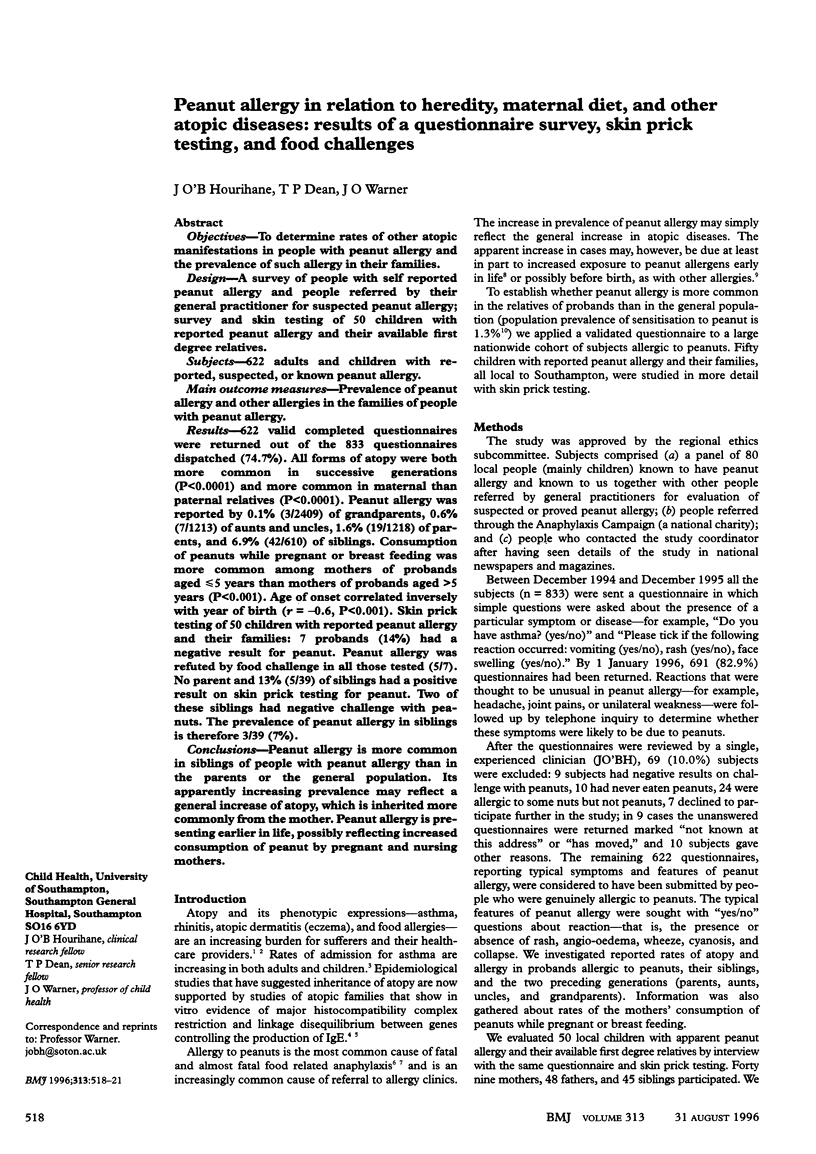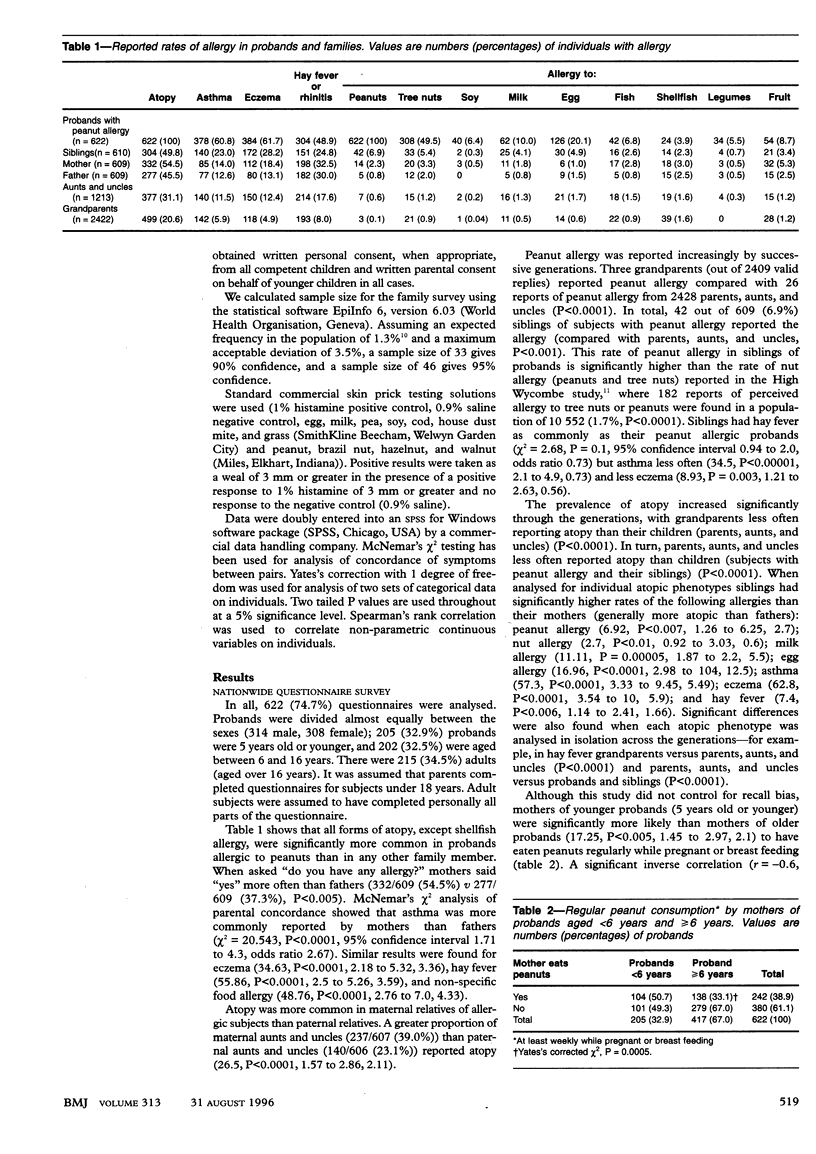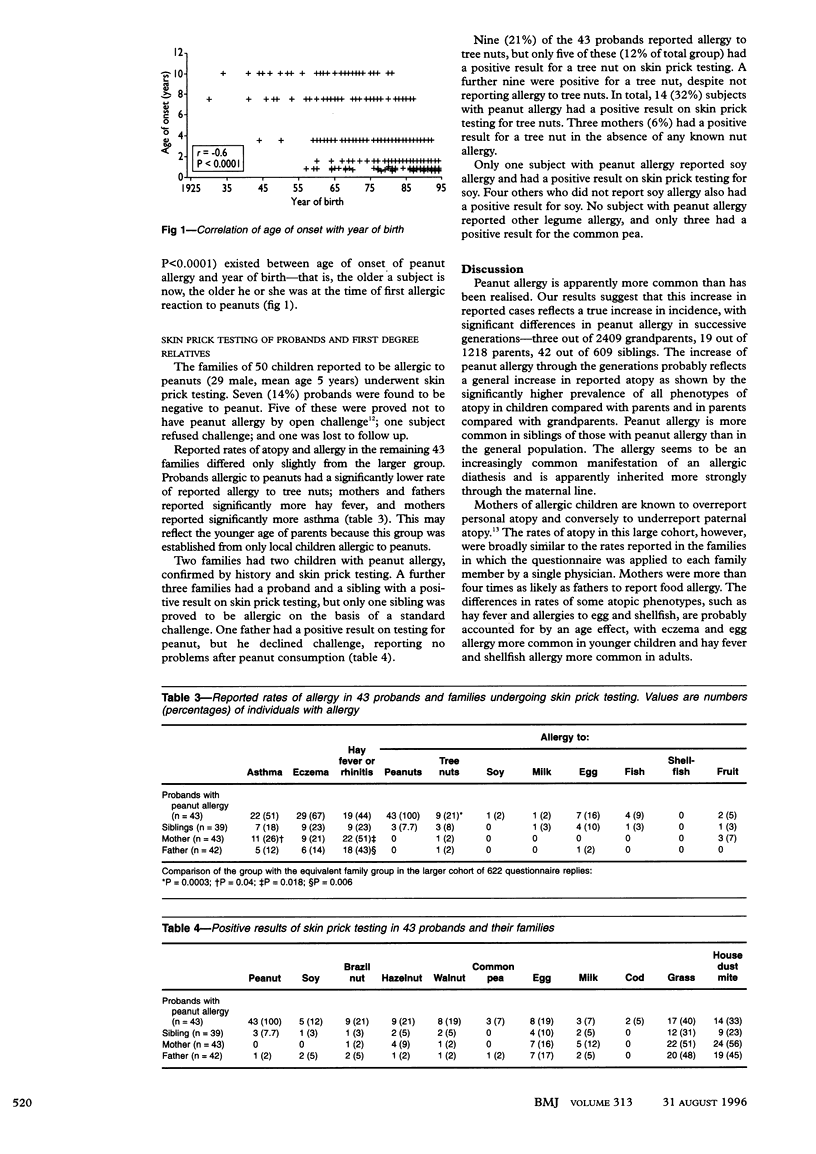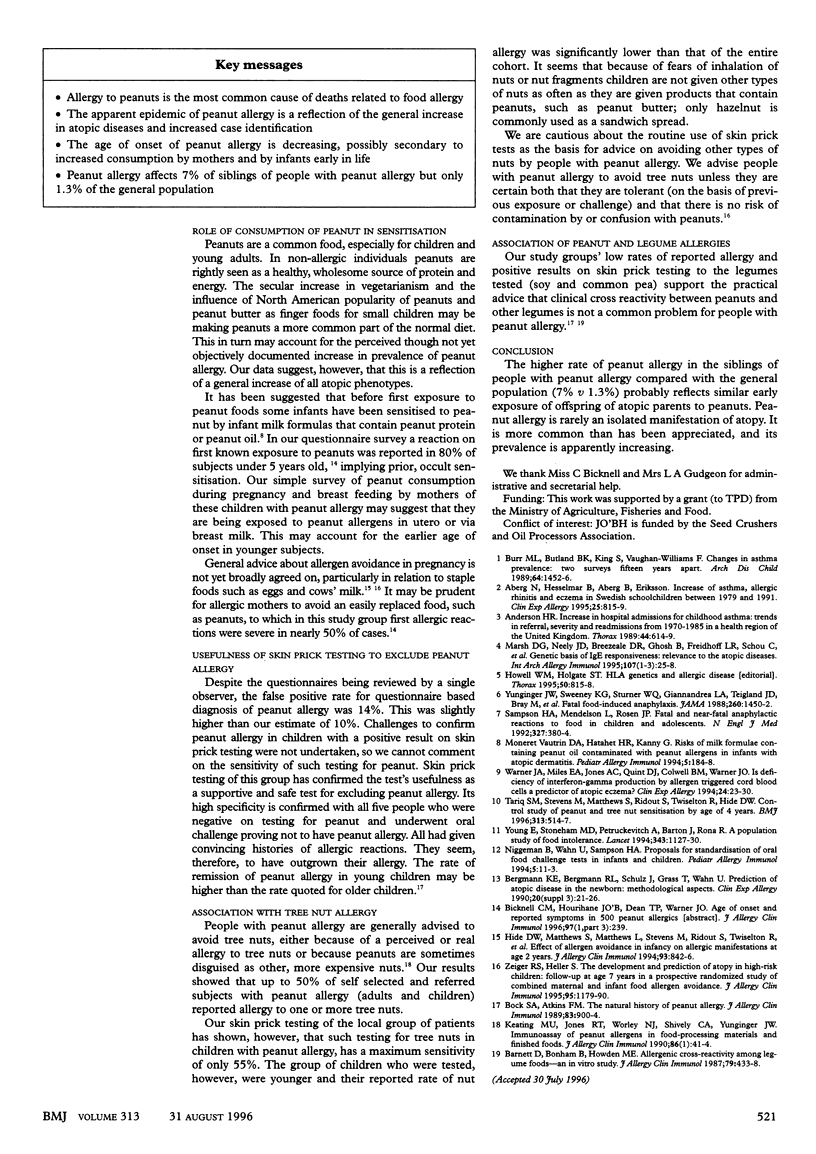Abstract
OBJECTIVES: To determine rates of other atopic manifestations in people with peanut allergy and the prevalence of such allergy in their families. DESIGN: A survey of people with self reported peanut allergy and people referred by their general practitioner for suspected peanut allergy; survey and skin testing of 50 children with reported peanut allergy and their available first degree relatives. SUBJECTS: 622 adults and children with reported, suspected, or known peanut allergy. MAIN OUTCOME MEASURES: Prevalence of peanut allergy and other allergies in the families of people with peanut allergy. RESULTS: 622 valid completed questionnaires were returned out of the 833 questionnaires dispatched (74.7%). All forms of atopy were both more common in successive generations (P < 0.0001) and more common in maternal than paternal relatives (P < 0.0001). Peanut allergy was reported by 0.1% (3/2409) of grandparents, 0.6% (7/1213) of aunts and uncles, 1.6% (19/1218) of parents, and 6.9% (42/610) of siblings. Consumption of peanuts while pregnant or breast feeding was more common among mothers of probands aged < or = 5 years than mothers of probands aged > 5 years (P < 0.001). Age of onset correlated inversely with year of birth (r = -0.6, P < 0.001). Skin prick testing of 50 children with reported peanut allergy and their families: 7 probands (14%) had a negative result for peanut. Peanut allergy was refuted by food challenge in all those tested (5/7). No parent and 13% (5/39) of siblings had a positive result on skin prick testing for peanut. Two of these siblings had negative challenge with peanuts. The prevalence of peanut allergy in siblings is therefore 3/39 (7%). CONCLUSIONS: Peanut allergy is more common in siblings of people with peanut allergy than in the parents or the general population. Its apparently increasing prevalence may reflect a general increase of atopy, which is inherited more commonly from the mother. Peanut allergy is presenting earlier in life, possibly reflecting increased consumption of peanut by pregnant and nursing mothers.
Full text
PDF



Selected References
These references are in PubMed. This may not be the complete list of references from this article.
- Aberg N., Hesselmar B., Aberg B., Eriksson B. Increase of asthma, allergic rhinitis and eczema in Swedish schoolchildren between 1979 and 1991. Clin Exp Allergy. 1995 Sep;25(9):815–819. doi: 10.1111/j.1365-2222.1995.tb00023.x. [DOI] [PubMed] [Google Scholar]
- Anderson H. R. Increase in hospital admissions for childhood asthma: trends in referral, severity, and readmissions from 1970 to 1985 in a health region of the United Kingdom. Thorax. 1989 Aug;44(8):614–619. doi: 10.1136/thx.44.8.614. [DOI] [PMC free article] [PubMed] [Google Scholar]
- Barnett D., Bonham B., Howden M. E. Allergenic cross-reactions among legume foods--an in vitro study. J Allergy Clin Immunol. 1987 Mar;79(3):433–438. doi: 10.1016/0091-6749(87)90359-9. [DOI] [PubMed] [Google Scholar]
- Bergmann K. E., Bergmann R. L., Schulz J., Grass T., Wahn U. Prediction of atopic disease in the newborn: methodological aspects. Clin Exp Allergy. 1990 Sep;20 (Suppl 3):21–26. doi: 10.1111/j.1365-2222.1990.tb02466.x. [DOI] [PubMed] [Google Scholar]
- Bock S. A., Atkins F. M. The natural history of peanut allergy. J Allergy Clin Immunol. 1989 May;83(5):900–904. doi: 10.1016/0091-6749(89)90103-6. [DOI] [PubMed] [Google Scholar]
- Burr M. L., Butland B. K., King S., Vaughan-Williams E. Changes in asthma prevalence: two surveys 15 years apart. Arch Dis Child. 1989 Oct;64(10):1452–1456. doi: 10.1136/adc.64.10.1452. [DOI] [PMC free article] [PubMed] [Google Scholar]
- Cardot E., Tillie-Leblond I., Jeannin P., Facon A., Breuil K., Patte F., Tonnel A. B. Anaphylactic reaction to local administration of rifamycin SV. J Allergy Clin Immunol. 1995 Jan;95(1 Pt 1):1–7. doi: 10.1016/s0091-6749(95)70145-1. [DOI] [PubMed] [Google Scholar]
- Hide D. W., Matthews S., Matthews L., Stevens M., Ridout S., Twiselton R., Gant C., Arshad S. H. Effect of allergen avoidance in infancy on allergic manifestations at age two years. J Allergy Clin Immunol. 1994 May;93(5):842–846. doi: 10.1016/0091-6749(94)90375-1. [DOI] [PubMed] [Google Scholar]
- Howell W. M., Holgate S. T. HLA genetics and allergic disease. Thorax. 1995 Aug;50(8):815–818. doi: 10.1136/thx.50.8.815. [DOI] [PMC free article] [PubMed] [Google Scholar]
- Marsh D. G., Neely J. D., Breazeale D. R., Ghosh B., Freidhoff L. R., Schou C., Beaty T. H. Genetic basis of IgE responsiveness: relevance to the atopic diseases. Int Arch Allergy Immunol. 1995 May-Jun;107(1-3):25–28. doi: 10.1159/000236920. [DOI] [PubMed] [Google Scholar]
- Niggemann B., Wahn U., Sampson H. A. Proposals for standardization of oral food challenge tests in infants and children. Pediatr Allergy Immunol. 1994 Feb;5(1):11–13. doi: 10.1111/j.1399-3038.1994.tb00212.x. [DOI] [PubMed] [Google Scholar]
- Tariq S. M., Stevens M., Matthews S., Ridout S., Twiselton R., Hide D. W. Cohort study of peanut and tree nut sensitisation by age of 4 years. BMJ. 1996 Aug 31;313(7056):514–517. doi: 10.1136/bmj.313.7056.514. [DOI] [PMC free article] [PubMed] [Google Scholar]
- Young E., Stoneham M. D., Petruckevitch A., Barton J., Rona R. A population study of food intolerance. Lancet. 1994 May 7;343(8906):1127–1130. doi: 10.1016/s0140-6736(94)90234-8. [DOI] [PubMed] [Google Scholar]
- Yunginger J. W., Sweeney K. G., Sturner W. Q., Giannandrea L. A., Teigland J. D., Bray M., Benson P. A., York J. A., Biedrzycki L., Squillace D. L. Fatal food-induced anaphylaxis. JAMA. 1988 Sep 9;260(10):1450–1452. [PubMed] [Google Scholar]


